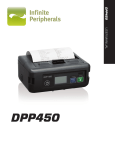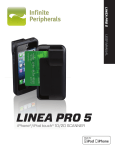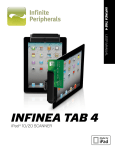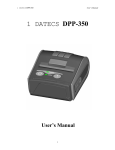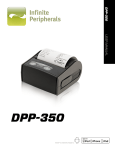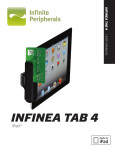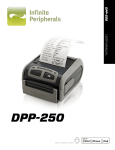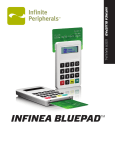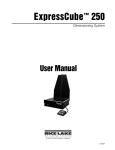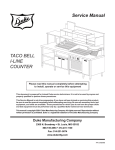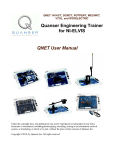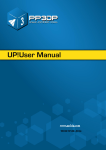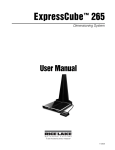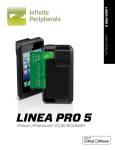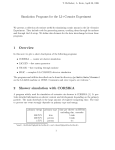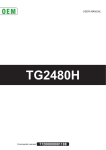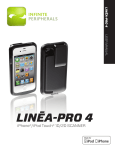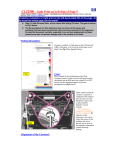Download DPP-450 - Infinite Peripherals
Transcript
DPP-450 USER MANUAL DPP-450 AndroidTM is a trademark of Google Inc. CONTACT INFORMATION Mobility Sales/Technical Center: Infinite Peripherals, Inc. 1641 McGaw Avenue Irvine, CA 92614 Toll Free: (866) 278-7860 Office: (949) 222-0300 Fax: (949) 222-0375 Headquarters/Main Warehouse: Infinite Peripherals, Inc. 2312 Touhy Elk Grove Village, IL 60004 Toll Free: (800) 278-7860 Phone: (847) 818-1260 Fax: (847) 818-1287 Technical Support: Infinite Peripherals, Inc. 1641 McGaw Avenue Irvine, CA 92614 Office: (949) 222-0300 Fax: (949) 222-0375 Email [email protected] ipcprint.com CONTENTS Contents Legal Notice Compatability Technical Data Box Contents Getting Started About Your DPP-450 Charging Your DPP-450 Status and Operational Modes Loading paper Label Paper Loading Diagnostic Self-Test Diagnostic Self-Test Memory Switch Setting Hardware Setup Configuration Menu Options Diagnostic Information Protocol Mode Dimensions Belt Clip Assembly Bluetooth® Setup iOS Bluetooth® Setup Android Replacing Battery Developing Solutions Troubleshooting Resident Command Set Federal Communications Commission 1 2 3 4 5 6 7 8 9 10 11 12 13 14 15 16 18 19 21 22 23 24 25 26 27 28 32 LEGAL NOTICE “Made for iPod,” “Made for iPhone,” and Made for iPad” mean that an electronic accessory has been designed to connect specifically to iPod, iPhone, or iPad, respectively and has been certified by the developer to meet Apple performance standards. Apple is not responsible for the operation of this device or its compliance with safety and regulatory standards. Please note that the use of this accessory with iPod, iPhone or iPad may affect wireless performance. iPod, iPhone, iPad touch are trademarks of Apple Inc., registered in the U.S. and other countries. Lightning is a trademark of Apple Inc. The Bluetooth® word mark and logos are owned by the Bluetooth® SIG, Inc. and any use of such marks by Infinite Peripherals is under license USER MANUAL | 2 COMPATABILITY Made for iPhone 5 iPhone 4S iPhone 4 th iPod touch (5 generation) th iPod touch (4 generation) iPod touch (3 rd generation) iPad (4th generation) iPad mini iPad (3rd generation) iPad 2 Android Support Android iOS 2.1 and higher USER MANUAL | 3 TECHNICAL DATA General Specifications Printing Specs Printing Method Line thermal dot printing Printing Speed 150mms/s (1200 dots/sec) Print Width 104mm / 832 dots per line Resolution 203dpi (8x8 dots/mm) Loadable fonts Horizontal – 0.125 mm (8 dots/mm) Vertical – 0.125 mm (8 dots/mm) Font А: 12 х 24 dots (48 char. per line); Font B: 9 х 16 dots (64 char. per line); Font C: 12 х 24 dots (48 char. per line); Font D: 9 х 16 dots (64 char. per line); Logo Registration 1 Black and White size: 832 x 248 dots Input Buffer 128 KB (131072 bytes) Dot pitch Resident fonts Resident Barcodes Communications Emulation Thermal Paper 1D -EAN13, EAN8, UPC-A, UPC-E, Codebar, Code39, Code128 2D – PDF417, QR Code RS232 C – max. 115200 bps, USB v 1.1, compatible with 2.0 Bluetooth® (Optional) – for iOS and Android platforms ESC/POS / LABEL (Continuous paper Mode, Black Mark Mode) Thermal Paper Roll: 115 mm / Ø 45 mm, thickness 60 µm Label Paper Roll: 115 mm / Ø 45 mm Electrical Power Supply Rechargeable Li-ion battery (14.8 V / 2200 mAh) Battery capacity: Per Charge (~30,000 lines) AC adapter – DC 24 V, 5 A AC 100 – 240 V, 50/60 Hz Magnetic Stripe Reader Not applicable Environm ent Temperature Operating temp. +0°C to +40°C @ 35 to 85 % RH Storage temp. -20°C to +60°C @ 10 to 90% RH Reliability Printing Head: 50km (printing rate 25% max), (MCBF): 15,000,000 lines M echanical Dimensions 136 (W) X 123 (D) Х 51 (H) Weight 785 g (without paper) 990 g (with paper) * Specifications subject to change without notice. USER MANUAL | 4 BOX CONTENTS Your DPP-450 comes with the following items listed below: DPP-450 Thermal Printer Belt Clip Power Supply Sample Paper Roll RS-232 Interface cable Software Drivers & SDK Because of the continually evolving Driver & SDK to support new mobile devices, Drivers & SDK are distributed online and is available for download at our website indicated below. For the latest on using the DPP-450 Drivers & SDK, please refer to the SDK’s documentation. For the latest DPP-450 Drivers & SDK’s, please visit our download area: http://ipcprint.com/developer/downloads USER MANUAL | 5 GETTING STARTED The DPP-450 allows you to print from your smartphone over Bluetooth®. Before using your DPP-450 the battery should be properly charged. The following Quick Start guide will help to get your DPP-450 ready for use. Quick Start Guide W hat to do 1 Fully charge your DPP-450 as recommended in this manual The battery pack should be fully charged before use to ensure long battery life Charging Battery, Page 8 2 Load DPP-450 print media (thermal Paper) DPP-450 requires Thermal paper for printing Loading paper, page 10 and 11 3 4 Purpose W here to find more information Step Install DPP-450 Software Printing requires software to be installed onto your mobile device Setup Bluetooth® pairing Set up Bluetooth® pairing to allow DPP-450 to communicate with the Bluetooth®. Printing software is not provided by Infinite Peripherals. account manager for recommendations on Third-party solutions. Developers should refer to the section in this manual on “Developing Solutions”. Bluetooth® Setup, page 22 and 23. USER MANUAL | 6 ABOUT YOUR DPP-450 DPP-450 Right View Paper Cover Latch Paper Cover Power Button USB/RS232C Port Print Button Paper Feed Button Battery Location DPP-450 Back View 2 Battery Charging Jack USER MANUAL | 7 CHARGING YOUR DPP-450 The DPP-450 uses a Lithium Ion rechargeable battery pack. Before first use, the battery pack should be charged for at least (4) hours from full empty. To prevent electrical damage to the DPP-450 and/or battery pack, please use approved AC adaptors cables only. Connect 24V charger cable to the DC charging jack as shown below. Insert cable to DC jack to start charging. When the device is turn on (holding turn on/off button), the LCD display will show “CHG” text and a green led “CHARGE” is blink. Solid RED = charging Solid GREEN = fully charged (~4 hrs.) 1 W arning: • When charging the DPP-450, only use the approved/recommended 24 volt @ 5 amp DC adaptors. Failure to do so may cause charging problems and potential damage to the DPP-450. • When connecting the DC charging cable, take care as to not force the plug into the connector as doing so may cause damage to the connector. USER MANUAL | 8 STATUS AND OPERATIONAL MODES The DPP-450 uses LEDs to indicate various conditions of operation. This may be charging, active or online, battery low conditions. The following explains these conditions and LED indication. LED Status Solid indicates battery charged. CHARGE Flashing indicates charging. Off indicates printer ready. STATUS Solid indicates paper empty. Flashing indicates error. USER MANUAL | 9 LOADING PAPER 1. Push lever in the direction of the arrow to open paper cover. 2. To set paper size – pull up green lever and slide right for small paper or left for wider paper. 3. Drop in new paper roll with about ½ fold over the front of the printer as shown in the figure below then close the paper cover securely. USER MANUAL | 10 LABEL PAPER LOADING 1. Push lever in the direction of the arrow to open paper cover. 2. Drop in new label roll with about ½ fold over the front of the printer as shown in the figure below then close the paper cover securely 3. Slide peeler in the direction of the arrow below. USER MANUAL | 11 DIAGNOSTIC SELF-TEST The DPP-450 has a built-in test pattern that shows the printer’s current configuration as well as the various resident printer fonts. The self-test can also be used as a troubleshooting tool to determine printing problems or battery level. The steps below show how the self-test is printed activated. • Holding <LF> button while power on for ~ 0.5 seconds (first beep) sound signals the short self-test will be printed as shown in the figure on the right. USER MANUAL | 12 DIAGNOSTIC SELF-TEST • Holding <LF> button for ~ 5.5 seconds (third beep) while powering on the DPP-450 will signal the longtest will be printed as shown in the figure on the right. • Resident font sizes • Characters per line • Text formatting • Resident character set • Resident barcode symbols • Printer’s configuration USER MANUAL | 13 MEMORY SWITCH SETTING The DPP-450 uses nonvolatile memory for storing some of the printer default Memory Switch Options Memory Switch (See command reference GS command) 1000000010 Baud Rate 115200 bps Auto Off Time 10 minutes Print Darkness 100% Character Table Western (1252) USB Device Class Printer configuration. The following table shows the available options. USER MANUAL | 14 HARDWARE SETUP • Holding the <ON/OFF> button while power on the DPP-450 printer for more than 6 seconds will enter hardware setup mode. The “STATUS” (red led) will blink once and DPP-450 will print the message in the figure below: • While in hardware setup mode, press <FEED> button to enter Hardware menu options. The DPP-450 will print the current saved settings. • The figure below show the LCD in hardware configuration menu: • Use the <PRINT> button to move down and use the <FEED> button to select selected. USER MANUAL | 15 CONFIGURATION MENU OPTIONS • FACTORY DEFAULT o o • MEMORY SWITCHES: o o o o o o o o o o o o o o • • • • 115200 bps 38400 bps 31200 bps 2400 bps 4800 bps 9600 bps 19200 bps 57600 bps IrDA BAUD RATE - Changing the IrDA communication speed o o o o o • ENABLE SOUND Enable/Disable printer's buzzer EXECUTE <CR> AS <LF> Disable CR/CR is executed as LF DISABLE <LF> COMMAND Enable/Disable LF DISABLE<LF>AFTER Disable LF immediately after CR DEFAULT SMALL FONT Set the small font as default USE GAP SENSOR Enable/Disable the GAP sensor BLACK MARK MODE Enable/Disable the black mark sensor XON/XOFF Enable/Disable XON/XOFF protocol ENABLE USB INTERFACE Enable/Disable USB communication port USB IN DEVICE MODE Changing the USB HOST/DEVICE mode PROTOCOL MODE Enable/Disable Protocol mode DISABLE BLUETOOTH ® Enable/Disable Bluetooth® communication DEFAULT SELECT DISP Set the main display as default DISABLEDISCOVERABILITY Enable/Disable printer's discoverability LCD FOREIGN LANGUAGE DISCARD - Exit without saving configuration ACCEPT - Exit with saving configuration BAUDRATE - Changing the printer communication speed (RS) o o o o o o o o • YES NO 19200 bps 9600 bps 38400 bps 57600 bps 115200 bps AUTO OFF TIME - Changing the printer's auto OFF time o o o o o o o o o 10 min. 15 min. 20 min. 30 min. 45 min. 60 min. 0 min. 2 min. 5 min. USER MANUAL | 16 • PRINT DARKNESS - Changing the printing darkness o o o o o o o • CHARACTER TABLE - Changing the printer's character table o o o o o o o o o o o o o o o o o o o o o o o o o o o • Enable/Disable saving pairing info Disable authentication Change pairing info Save pairing info USB DEV. CLASS - Changing the USB device class of the printer o o • Western (1252) CE (1250) Turkish (1254) Baltic (1257) Cyrillic (1251) Greek (1253) Hebrew ( 1255) Katakana Arabic Arabic (1256) Arabic (1256A) Arabic (1256F) Thai (874) VISCII English (437) Latin 1 (850) Portuguese (860) Lithuanian Latin 2 (852) Polish Turkish (857) Baltic (775) Bulgarian (856) Russian (866) Latvian Greek (737) Hebrew (862) PAIRING INFO - Resetting pairing info o • • • • 120 % 140 % 160 % 60 % 75 % 90 % 100 % Printer Serial SAVE & EXIT MENU USER MANUAL | 17 DIAGNOSTIC INFORMATION The DPP-450 has several built-in diagnostic modes. LF Button operation Modes Holding <LF> button while power on for ~ 0.5 sec (first sound signal) Holding <LF> button while power on for ~ 2.5 sec (second sound signal) Holding <LF> button while power on for more than 8.5 sec (fifth 4-tone sound signal) SHORT SELF TEST print start DUMP mode. All input data are printed hexadecimal and as text Enter firmware updating mode 4 sec (first sound signal) If serial cable is connected (RS232 communication) – temporary forcing 9600 bps serial speed Holding <ON/OFF> button while power on for If no serial cable connected (Bluetooth® or USB communication) – starting a hardware menu for fast Bluetooth® pairing info reset Holding <ON/OFF> button while power on for more than 6 sec Enter hardware setup mode Holding <ON/OFF> button while power off for more than 1 Second Holding <ON/OFF> button while less than 1 second backlight is turn on for short time Holding <ON/OFF> button and press <LF> button Printing WIFI info USER MANUAL | 18 PROTOCOL MODE Protocol mode is active when hardware switch 11 is on. The purpose of this mode is to give stronger real time access to the printer. All input data are sent in packets as described below. The printer returns an answer to the packet immediately. Output packet format: Channel Command LenHi LenLo Data Answer format: Channel Status LenHi LenLo Data Channel: One byte: Bits 0 – 6Channel number (Device type) Bit 70: Send data; 1: Response Command: One byte with possible value: • • • • • 0: Open channel (No action – all channels always open) 1: Close channel (No action – all channels always open) 2: Send data 3: Request data >4: Application specific Status: One byte: 0 1 Bit 0 No error Error occurred Bit 1 ACK (Packet accepted) NACK (Packed not accepted) Bit 2 Channel and command OK Wrong channel or command Bit 3 Battery OK Low battery Bit 4 Printing head OK Printing head too hot Bit 5 Paper OK Out of paper Bit 6 Bit 7 Not defined Printer ready Printer busy Bit 7 is set, if: • • • • • There are unprinted lines in the print buffer. There are bytes in the print buffer. The printer is executing a macro. The printer is executing self test The button <LF> is pressed – feeding paper. LenHi: High byte of data length of data. 00h to 08h. LenLo: Low byte of data length of data. 00h to FFh. Data: 256*LenHi +LenLo data bytes. The maximum packet length is 2048 bytes. The answer differs from the command by bit 7 (MSB) in the channel number. If bit 7 is 0 then it is a command, if it is 1 then it is a response. Bit 0 in the status byte shows if there was an error accepting or processing the data block. If this bit is 1 the other bits show the type of the error. The printer never issues a transmission by itself. It always responds as an answer to a command. The communication goes like this: Host – command, Printer – answer; Host – command, Printer – answer; etc. USER MANUAL | 19 The defined channels are: • 1Printer. • 16 (10h) Optional card reader. Commands for the printer channel (1): • Command 2 - Send data The data is copied into the printer’s print buffer. If there’s not enough space into the print buffer the packet is rejected, and a status byte with value 3 is returned in the answer. • Command 3 - Receive data If there is data to be transmitted from the printer to the host, it is transmitted in the data field of the packet, otherwise an empty packet is received. The application must take care to get the data fast enough from the output buffer or the data may be corrupt. • Command 4 - Get printer status. 5 data bytes returned in response: o BufferHi BufferLo PrStatus Volt Temperature o BufferHiHigh byte of the count of free bytes in input buffer. o BufferLo Low byte of the count of free bytes in input buffer. o PrStatusPrinter status. The following bits defined: § Bit 0 Battery low § Bit 1 Too hot § Bit 2 No paper o Volt - The battery voltage in units 0.1V o Temperature - The head temperature in degrees Celsius. If free bytes in input buffer are more than 65535 (FFFFh), then FFFFh is returned. Using channel 16 is the only way for full control over the optional card reader. Communication example (all bytes hexadecimal): • Send data: o >>>01 02 00 05 11 22 33 44 55 o <<<81 00 00 00 • Send data with error: o >>>01 02 00 05 11 22 33 44 55 o <<<81 01 00 00 o >>>01 02 00 05 11 22 33 44 55 o <<<81 01 00 00 o >>>01 02 00 05 11 22 33 44 55 o <<<81 00 00 00 • Receive data: o >>>01 03 00 00 o <<<81 00 00 00 o >>>01 03 00 00 o <<<81 00 00 04 11 22 33 44 o >>>01 03 00 00 o <<<81 00 00 00 • Get status: o >>>01 04 00 00 o <<<81 00 00 05 3F F8 01 49 27 USER MANUAL | 20 DIMENSIONS USER MANUAL | 21 BELT CLIP ASSEMBLY The DPP-450 is designed to be worn on the belt using belt clip accessory. To assembly the printer and belt clip, follow the steps below. 1. Attach the belt clip to the base of the DPP-450 as shown below. Caution: • When securing the belt clip to the DPP-450 printer, use only the supplied screws to prevent damage to the printer. • Failure to use the recommended screws may not securely fasten belt clip to printer and cause the printer to separate from belt clip. USER MANUAL | 22 BLUETOOTH® SETUP IOS Enable Bluetooth® on iOS device. Select Bluetooth® device, after this Pair to DPP-450. Start app “Library Demo” and select “Print”. DPP-450 DPP-450 450 You can select “Print self test” to test Bluetooth® connection. USER MANUAL | 23 BLUETOOTH® SETUP ANDROID Enable Bluetooth® and press search device. On the list with available device will show “DDP-450”, pair device. Default PIN is “0000”. When is paired open application “Printer Sample”. Select a device to connect “DPP-450”. For testing Bluetooth® connection press “Print self test”. 450 DPP-450 DPP-450 USER MANUAL | 24 REPLACING BATTERY To replace the battery in the DPP-450 thermal printer follow the steps below. 4. Open the battery cover as shown in the figure below: 5. Slide locking lever to release battery as shown in the figure below Tips: Disconnect all cables including AC adaptor and turn off the DPP-450 printer before attempting to remove the battery. USER MANUAL | 25 DEVELOPING SOLUTIONS Integrating the DPP-450 into your mobile solution requires the use of the DPP450 smartphone SDK. The SDK incorporates API specific to developing printing applications and using the capabilities of the DPP-450 mobile printer. The table below shows the SDKs currently available for PDA & Smartphone devices. OS Language SDK - IDE Android Java Eclipse Apple iOS Obj. C Xcode (see Linea SDK) For details on using the DPP-450 SDK, please refer to the SDK’s documentation. For the latest DPP-450 SDK’s, visit our developer web site at: http://ipcprint.com/developer/downloads USER MANUAL | 26 TROUBLESHOOTING If you are having problem printing refer to the table below for possible causes. Item 1 Problem Paper feeds after issuing a print job but no printed text visible on paper. Possible Cause Thermal media is specially coated on outside of roll. Remove paper roll and reload properly. See section “Loading Paper” for details on loading paper. Paper cover not installed properly. See section “Loading Paper” for details on replacing paper cover. Paper not properly loaded. Press FEED button. 2 3 Status LED on RED continuously. Text and/or graphics are printed very light. Printer out of paper or Paper not properly loaded. See section “Loading Paper” for details on loading paper. Battery voltage low. battery pack. See section on charging Thermal media not imaging correctly. Verify that you are using the recommended thermal media. 4 Strange characters are printed when printing. Battery voltage low. battery pack. 5 Printer stops responding to print and paper feed commands. Remove battery for 5 seconds and reconnect battery. 6 Printing is light or missing only on half of the print width. See section on charging Paper cover not properly installed. See section on loading paper. Mechanism support. jarred loose. Contact technical USER MANUAL | 27 RESIDENT COMMAND SET No. Command Description 1 BEL Sounds the buzzer 2 HT Horizontal Tab command 3 LF Printing a line and paper Feeding command 4 FF Printing and paper feeding to the black mark position 5 CR The operation of the command depends on the state of the configuration flags 2,3 and 4 6 DC2= Image LSB/MSB select 7 DC3( DC3 (Ruled line) commands sequence start 8 DC3+ Sets the ruled line ON 9 DC3- Sets the ruled line Off 10 DC3A Selects ruled line A 11 DC3B Selects ruled line B 12 DC3C Clears selected ruled line buffer 13 DC3D Sets a single dot in selected ruled line buffer 14 DC3 F Ruled line pattern set 15 DC3 L Ruled line set 16 DC3 M Selects ruled line combine mode 17 DC3 P Ruled line 1 dot line print 18 DC3 p Ruled line n dots line print 19 DC3 v Ruled line image write 20 CAN 21 ESC FF Printing data in page mode 22 ESC RS Sounds the buzzer 23 ESC SP Setting character spacing 24 ESC # Setting EURO symbol position 25 ESC $ Specifying the absolute horizontal position of printing 26 ESC % Selecting/Canceling the printing of downloaded user character set Canceling print data in page mode USER MANUAL | 28 27 ESC & Selecting user character set 28 ESC ! Specifying printing mode of text data 29 ESC * Printing graphical data 30 ESC + Switch’s OFF the printer 31 ESC - Selecting/Canceling underlining 32 ESC . Printing self test/diagnostic information 33 ESC 2 Specifying 1/6-inch line feed rate 34 ESC 3 Specifying line feed rate n/203 inches 35 ESC < Changes print direction to opposite 36 ESC = Data input control 37 ESC > Selecting print direction 38 ESC ? Reading magnetic stripe card 39 ESC @ Initializing the printer 40 ESC CAL 41 ESC D Setting horizontal tab position 42 ESC E Specifying/Canceling highlighting 43 ESC F Filling or inverting the page area in page mode 44 ESC G Specifying/Canceling highlighting 45 ESC I Specifying/Canceling Italic print 46 ESC J Printing and Paper feed n/203 inches 47 ESC L Selecting page mode 48 ESC N Reading programmed serial number 49 ESC R Selecting country 50 ESC S Specifying speed (bps) of the serial port 51 ESC T Printing short self test 52 ESC U Selecting/Canceling underlined printing 53 ESC V Selecting/Canceling printing 90°- right turned characters 54 ESC W Defining the print area in page mode 55 ESC X Specifying max printing speed 56 ESC Y Selecting intensity level 57 ESC Z Returning diagnostic information Black mark mode sensor calibration USER MANUAL | 29 58 ESC \ Specifying relative horizontal position 59 ESC ] Loading the default settings stored in Flash memory 60 ESC ^ Saving current settings in Flash memory 61 ESC _ Loading factory settings 62 ESC ` Reading the Battery Voltage and Thermal head temperature 63 ESC a Aligning the characters 64 ESC b Increasing text line height 65 ESC c5 Enabling/Disabling the functioning of the button LF 66 ESC d Printing and feeding paper by n- lines 67 ESC i Feeding paper backwards 68 ESC o Temporarily feeding paper forward 69 ESC pair= Enabling/Disabling PAIRING info saving in Bluetooth® mode 70 ESC pwd= Programming a new Bluetooth® password (PIN) 71 ESC r Full command for sounding buzzer 72 ESC s Reading printer settings 73 ESC u Selecting code table 74 ESC v Transmitting the printer status 75 ESC x Setting the time interval for automatically switching Off the printer 76 ESC y Setting USB response strings 77 ESCy BTH: Enabling/Canceling printing of 180° turned characters 78 GS FF Printing in page mode and returning to standard mode 79 GS $ Specifying the absolute vertical position in page mode 80 GS ) Setting printer flags (memory switches) 81 GS * Defining a Downloaded Bit Image (logo) 82 GS / Printing a Downloaded Bit Image 83 GS : Starting/ending macro definitions 84 GS B Enabling/Disabling inverse printing (white on black) 85 GS C Read the Real Time Clock 86 GS H Selecting printing position of HRI Code 87 GS L Setting the left margin 88 GS Q Printing 2-D barcodes USER MANUAL | 30 89 GS R Filling or inverting a rectangle in page mode 90 GS S Selecting 2-D barcode cell size 91 GS T Selecting the print direction in page mode 92 GS U Selecting standard mode 93 GS W Setting the print area width 94 GS X Drawing a rectangular box with selected thickness in page mode 95 GS Z Printing the non blank page area only in page mode 96 GS \ Specifying the relative vertical position in page mode 97 GS ^ Executing macro 98 GS c Setting the Real Time Clock 99 GS f Setting the font of HRI characters of the barcode 100 GS h Setting the height of the barcode 101 GS k Printing a barcode 102 GS p Settings for 2D barcode PDF417 103 GS q Selecting the height of the module of 2D barcode PDF417 104 GS w Selecting the horizontal size (Scale factor) of the barcode 105 GS x Direct text print in page mode 6. Asian Languages Support 106 FS ! Specifying printing mode of two-byte text data 107 FS & Selecting two-byte text mode (JIS or GB2312) 108 FS - Selecting/Canceling underline mode for two-byte text mode 109 FS . Canceling two-byte text mode 110 FS C Selecting Shift-JIS mode (Japanese version only) 111 FS S Specifying character spacing for two-byte text mode 112 FS W Selecting double size characters for two-byte text mode USER MANUAL | 31 FEDERAL COMMUNICATIONS COMMISSION Federal Communications Commission (FCC) Statement 15.21 You are cautioned that changes or modifications not expressly approved by the part responsible for compliance could void the user’s authority to operate the equipment. 15.105(b) This equipment has been tested and found to comply with the limits for a Class B digital device, pursuant to part 15 of the FCC rules. These limits are designed to provide reasonable protection against harmful interference in a residential installation. This equipment generates, uses and can radiate radio frequency energy and, if not installed and used in accordance with the instructions, may cause harmful interference to radio communications. However, there is no guarantee that interference will not occur in a particular installation. If this equipment does cause harmful interference to radio or television reception, which can be determined by turning the equipment off and on, the user is encouraged to try to correct the interference by one or more of the following measures: - Reorient or relocate the receiving antenna. - Increase the separation between the equipment and receiver. - Connect the equipment into an outlet on a circuit different from that to which the receiver is connected. - Consult the dealer or an experienced radio/TV technician for help. Operation is subject to the following two conditions: 1) this device may not cause interference and 2) this device must accept any interference, including interference that may cause undesired operation of the device. FCC RF Radiation Exposure Statement: This equipment complies with FCC radiation exposure limits set forth for an uncontrolled environment. End users must follow the specific operating instructions for satisfying RF exposure compliance. This transmitter must not be co-located or operating in conjunction with any other antenna or transmitter. USER MANUAL | 32


































